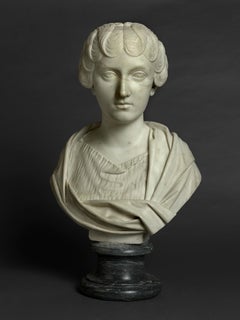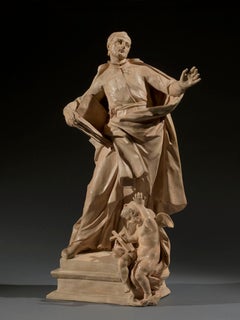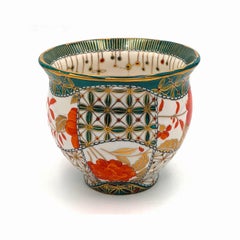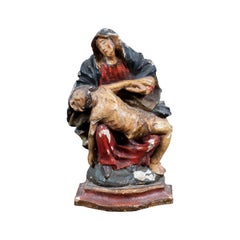Lowell Libson & Jonny Yarker Ltd Sculptures
to
2
Overall Width
to
Overall Height
to
2
2
1
2
1
1
1
1
1
1
1
1
1
1
2
Eighteenth-century Grand Tour marble bust of Faustina the Younger
Located in London, GB
Signed and dated: ‘F. Harwood Fecit 1764’
Collections:
Probably commissioned by Alexander Gordon, 4th Duke of Gordon (1743-1827);
Probably by descent at Gordon Castle, Banffshire to c.1948;
Possibly acquired by Bert Crowther of Syon Lodge, Middlesex;
Jacques Hollander (1940-2004);
Christie’s, 5 December 2013, lot 101;
Private collection;
Sotheby’s, 2 July 2019, lot 106
Literature:
John Preston Neale, Views of the seats of noblemen and gentlemen, in England, Wales and Scotland, London, 1822, vol.I, unpaginated.
This marble copy of an ancient bust in the Musei Capitolini usually identified as Faustina the Younger, the daughter of Antoninus Pius and future wife of Marcus Aurelius, was made in Florence by Francis Harwood in 1764. Harwood was one of the most prolific suppliers of decorative marbles for the Grand Tour market and this finely worked example demonstrates the quality of luxury goods available to travellers to Italy. So often anonymous, this unusually signed and dated example, raises questions about the status of marble copies in the period and of sculptors such as Harwood who are known principally for ornamental work.
Harwood’s origins remain obscure. He is documented living in Palazzo Zuccari with Joshua Reynolds and the Irish sculptor Simon Vierpyl at Easter 1752, he had certainly settled permanently in Florence by the following year, when he is recorded working with Joseph Wilton. He was admitted to the Florentine Academy on 12 January 1755 (as pittore Inglese, although he was described as scultore in the matriculation account). After Wilson returned to England in 1755 Harwood appears to have worked in a studio near SS. Annunziata with Giovanni Battista Piamontini who had made life-size copies of The Wrestlers and The Listening Slave for Joseph Leeson in 1754. In 1758 both sculptors were contracted to make a statue and a trophy to complete the decoration of the Porta San Gallo, Harwood completing a statue of Equality, installed the following year.
By 1760 Harwood was on the brink of his most productive period as a sculptor, producing copies of celebrated antiquities for the ever-increasing audience of Grand Tour travellers and for the domestic market in London. In 1761 Harwood met the young architect James Adam who was in Italy specifically to make contact with suppliers for Robert Adam’s burgeoning practice back in Britain. The Adams offered a remarkably cohesive design package to their clients, encompassing not just architecture, but fixtures, fittings and furniture as well. Harwood was able to supply the brothers with marbles for their new interiors. At Syon, for example, Harwood produced a full-size copy of Michelangelo’s Bacchus for the new dining room the Adams had designed for Hugh Smythson, 1st Duke of Northumberland.
Harwood seems to have also specialised in producing sets of library busts. In 1758 Charles Compton, 7th Earl of Northampton, a distinguished traveller commissioned a set of busts which remain in situ at Castle Ashby in Northamptonshire. It is perhaps no coincidence that the Adam brothers were producing designs for new interiors at Castle Ashby at this date. The set included representations of: Cicero, Julius Caesar, Marcus Aurelius, Faustina the Younger, Sappho, Seneca and Homer. Each of these busts Harwood seems to have replicated for multiple patrons, another Adam patron, Thomas Dundas...
Category
18th Century Old Masters Figurative Sculptures
Materials
Marble
Roman 18th century terracotta model for the sculpture of San Camillo de Lellis
Located in London, GB
This remarkably fluid terracotta bozetto was made in preparation for Pietro Pacilli’s most important public commission, a large-scale marble statue of San Camillo de Lellis for the nave of St Peter’s Basilica in Rome. Expressively modelled, this terracotta sculpture is a rare and significant work made by a major Roman sculptor at a transformative moment of European sculpture. Pacilli began his working life on the great Baroque decorative projects initiated in the seventeenth century, but he found success as a restorer of ancient sculpture working to finish antiquities for a tourist market, becoming an important figure in the emergence of an archaeologically minded Neoclassicism. Pacilli trained Vincenzo Pacetti and provided important decorative work for the Museo Pio-Clementino, at the same time he is recorded restoring some of the most celebrated antiquities excavated and exported during the period.
Pacilli was born into a family of Roman craftsmen, his father Carlo was a wood carver, and Pacilli is recorded working with him on the Corsini Chapel in San Giovanni Laternao as early as 1735. In 1738 his terracotta model of Joseph and Potiphar’s Wife won the first prize in the second class of the sculpture concorso at the Accademia di San Luca, this is particularly notable as Bartolomeo Cavaceppi came third. He worked as a carver and stuccoist completing works for the churches of San Marco and SS. Trinita dei Domeniciani Spagnoli. Pacilli operated as a sculptor and restorer of antiquities from his studio at the top of the Spanish Steps, close to Santa Trinita dei Monti, where he is listed as a potential vendor to the Museo Pio-Clementino in 1770.
In 1763 Pacilli completed a silver figure of San Venanzio for the treasury of San Venanzio. He is recorded as Pacetti’s first master and it was evidently through Pacilli that he began to acquire his facility as a restorer of ancient sculpture. Pacilli, at his studio ‘poco prima dell’Arco della Regina alla Trinita dei Monti,’ exercised, what the nineteenth-century scholar, Adolf Michaelis called ‘rejuvenating arts’ on several important pieces of classical sculpture, including in 1760 the group of a Satyr with a Flute for the natural brother of George III, General Wallmoden, Hanovarian minister at Vienna. In 1765, Dallaway and Michaelis record that Pacilli was responsible for the restorations, including the addition of a new head, to the Barberini Venus which he had acquired from Gavin Hamilton. The Venus was then sold to Thomas Jenkins, who in turn passed it on to William Weddell at Newby Hall. In 1767 Pacilli exported a series of ancient busts ‘al naturale’ including portraits of Antinous, Julius Ceaser and Marus Aurelius, also a statue of a Muse and a Venus. As early as 1756 Pacilli seems to have been operating as an antiquarian, helping to disperse the collection of the Villa Borrioni. Pacilli supplied sculpture to notable British collectors, including Charles Townley, who on his first trip to Italy purchased the Palazzo Giustiniani statue of Hecate from Pacilli. Pacilli was involved with the Museo Pio Clementino from its conception, supplying busts of Julius Ceaser and a Roman Woman as well as completing stucco putti surmounting the arms of Pope Bendedict XIV to signal the entrance to the new Museo Critiano.
In 1750 Il Diario Ordinario del Chracas announced that Pacilli had begun work on a sculpture of San Camillo de Lellis for St Peter’s. Camillo de Lellis founded his congregation, the Camillians, with their distinctive red felt crosses stitched on black habits in 1591. Having served as a soldier in the Venetian army, Camillo de Lellis became a novitiate of the Capuchin friars, he moved to Rome and established a religious community for the purpose of caring for the sick. In 1586 Pope Sixtus V formerly recognised the Camillians and assigned them to the Church of Santa Maria Maddalena in Rome. Camillo de Lellis died in 1614 and was entombed at Santa Maria Maddalena, he was canonised by Benedict XIV on June 26, 1746. It was an occasion that prompted the Camillians to make a number of significant artistic commissions, including two canvases by Pierre Subleyras showing episodes from San Camillo’s life which they presented to Benedict XIV. In 1750 Pacilli was commissioned to fill one of the large niches on the north wall of the nave with a sculpture of San Camillo.
The present terracotta bozetto presumably had two important functions, to enable Pacilli to work out his ideas for the finished sculpture and at the same time to show his design to the various commissioning bodies. In this case it would have been Cardinal Alessandro Albani and Monsignor Giovan Francesco Olivieri, the ‘economo’ or treasurer of the fabric of St Peter’s. Previously unrecorded, this terracotta relates to a smaller, less finished model which has recently been identified as being Pacilli’s first idea for his statue of San Camillo. Preserved in Palazzo Venezia, in Rome, the terracotta shows San Camillo with his left hand clutching his vestments to his breast; the pose and action more deliberate and contained than the finished sculpture. In producing the present terracotta Pacilli has expanded and energised the figure. San Camillo is shown with his left hand extended, his head turned to the right, apparently in an attempt to look east down the nave of St Peter’s. The model shows Pacilli experimenting with San Camillo’s costume; prominently on his breast is the red cross of his order, whilst a sense of animation is injected into the figure through the billowing cloak which is pulled across the saint’s projecting right leg. The power of the restrained, axial contrapposto of bent right leg and outstretched left arm, is diminished in the final sculpture where a baroque fussiness is introduced to the drapery. What Pacilli’s terracotta demonstrates, is that he conceived the figure of San Camillo very much in line with the immediate tradition of depicting single figures in St Peter’s; the rhetorical gesture of dynamic saint, arm outstretched, book in hand, head pointed upwards was perhaps borrowed from Camillo Rusconi’s 1733 sculpture of St. Ignatius...
Category
18th Century Baroque Figurative Sculptures
Materials
Terracotta
Related Items
Yunomi (MADE TO ORDER) (Sabbath, Kiddush, Ceremonial Vessel)
By Melanie Sherman
Located in Kansas City, MO
(MADE TO ORDER) (Sabbath, Kiddush, Ceremonial Vessel)
*Lead Time may vary between 1-3 weeks
Melanie Sherman
"Yunomi"
Year: 2021
Porcelain, Glaze, ChinaPaint, 24k German Gold Luster,...
Category
2010s Baroque Sculptures
Materials
Porcelain, Luster, Glaze
$398
H 3.25 in W 3.5 in D 3.5 in
Italian master - 18th century figure sculpture - Virgin Pity - Carved Wood Paint
Located in Varmo, IT
Carved and painted wooden sculpture - Pietà - Italy, 18th century.
13 x 7 x h 22.5 cm.
Entirely made of carved and polychrome painted wood.
Condition report: Good state of conserv...
Category
Mid-18th Century Old Masters Figurative Sculptures
Materials
Wood, Paint
$827 Sale Price
22% Off
H 5.12 in W 2.76 in D 8.86 in
The Rape of Sabine Iconic Bronze Sculpture 1930
Located in Rome, IT
Fine Group of Sculptures in Bronze after Jean de Boulogne (Giambologna)
The torturously twisting Rape of the Sabine Women is one of the finest and most technically difficult sculpt...
Category
1920s Mannerist Figurative Sculptures
Materials
Bronze
$6,620 Sale Price
30% Off
H 35.44 in W 8.27 in D 8.27 in
Antique Italian sculptor - 18/19th century terracotta sculpture - Memento Mori
Located in Varmo, IT
Terracotta sculpture - Memento mori. Italy, 18th-19th century.
16 x 25 x h 18 cm.
Entirely in terracotta.
- This item is sold with a certificate of authenticity with legal validi...
Category
Late 18th Century Old Masters Figurative Sculptures
Materials
Terracotta
$2,600 Sale Price
21% Off
H 7.09 in W 6.3 in D 9.85 in
Apollo Sculpture /// Contemporary Classics Mythology Head Painted Colorful Art
By Jack Graves III
Located in Saint Augustine, FL
Artist: Jack Graves III (American, 1988-)
Title: "Apollo Sculpture"
Series: Sculpture
*Signed, titled, and dated by Graves on bottom
Year: 2022
Mediu...
Category
2010s Contemporary Figurative Sculptures
Materials
Cast Stone, Marble
$1,000
H 12.25 in W 8.5 in D 4.75 in
Flemish Hercules and the Lernaean Hydra Bronze
Located in New Orleans, LA
This remarkable early 17th-century Flemish bronze of Hercules and the Lernaean Hydra exudes classic Baroque grandeur and beauty. Flanders was one of the richest artistic and cultural...
Category
Early 17th Century Baroque Figurative Sculptures
Materials
Bronze
$98,500
H 22.5 in W 8.75 in D 6.75 in
Baroque Venetian sculptor - Pair of 17th century lions wood sculptures
Located in Varmo, IT
Pair of bookend sculptures. Venice, 17th century.
15 x 15 x h 29 cm.
Entirely in finely carved wood.
- This item is sold with a certificate of authenticity with legal validity.
-...
Category
Early 17th Century Baroque Figurative Sculptures
Materials
Wood
$2,364 Sale Price
20% Off
H 5.91 in W 5.91 in D 11.42 in
Rare and Important Italian Alabaster Bust Sculpture of Jesus Christ, C. 1860
Located in Queens, NY
A rare and important Italian alabaster bust sculpture of Jesus Christ, C. 1860
A modeled bust of Holy Christ wearing a crown of thorns, exceptional...
Category
19th Century Baroque Figurative Sculptures
Materials
Alabaster
$110,000
H 21 in W 11 in D 4 in
Pair of 19th century scagliola sculptures (Italian Neoclassicism) - Roman figure
Located in Varmo, IT
Pair of scagliola sculptures - Roman figures. Italian manufacture, 19th century.
51 x 26 x h 118 cm (left) - 41 x 28 x h 118 cm (right).
Made entirely of scagliola. Depicting two f...
Category
Early 19th Century Old Masters Figurative Sculptures
Materials
Plaster
$5,674 Sale Price
20% Off
H 46.46 in W 20.08 in D 10.24 in
Pair of 19th Century Busts by Albert Ernest Carrier-Belleuse
By Albert-Ernest Carrier-Belleuse
Located in Santa Fe, NM
Signed: A. Carrier-Belluese
Two large bronze matching busts of an unknown male and female
22 x 10 x 11" male
23 x 10 x 9" female
Both show signs of wear with their age but are in fa...
Category
19th Century Baroque Figurative Sculptures
Materials
Marble, Bronze
$6,000 Sale Price
50% Off
H 23 in W 22 in D 10 in
Baroque Roman sculptor - 17th century bronze sculpture - Mars Warrior
Located in Varmo, IT
Gilded bronze sculpture - Mars, god of War. Rome, 17th century.
9 x 9 x h 31 cm.
Entirely in cast, chiseled and gilded bronze, resting on an ebonized wooden pedestal decorated with...
Category
Mid-17th Century Baroque Figurative Sculptures
Materials
Bronze
$4,137 Sale Price
41% Off
H 12.21 in W 3.55 in D 3.55 in
Vintage Peacock III (Wall Piece/Dish (hand-painted, made to order by the artist)
By Melanie Sherman
Located in Kansas City, MO
Melanie Sherman
Vintage Peacock III (Wall Piece/Dish (handpainted)
Porcelain, Glaze, Overglaze, Chinapaints, 24k German Gold Luster, Brass Wire (for hanging, can be removed)
Year: 2023 (and following years)
Size: 5.5x4x0.25in
Signed by hand
COA provided
Ref.: 924802-1333
*Made to Order Every piece is unique, design might differ slightly Customization possible
**Lead time approx. 2 weeks for qty 1-3
------------------------
My ceramics are handmade and painted with the finest overglazes from Europe. The gold luster used is 24k liquid Gold from Germany. Every piece is unique. My imagery is inspired by vintage Meissen dinnerware, William Morris wallpaper and other historical sources.
Porcelain, Ceramics, Pottery, Ornament
Vintage Moth Wall Piece Ornament Small Dish Candy Sugar Tea handpainted handmade butterfly peacock 24k German gold luster ceramics porcelain charm, jewelry, personalized, family, tree, retro, heart, mother, moon, baby, feet, gemstone, flower, mom, birth, year, art, chinapaint, luster, lustre, contemporary ceramics, futility of pleasure, herend, meissen, sevre, pattern, arita, arita ware, imari, imari ware, dresden, germany, japan, jingdezhen, china, photography, momento mori, flowers, flower motif, drawing, illustration, peacock, cherry blossom, chrysanthemum, kiku, 菊, kikka, 菊花, Ōka, 黄花, Kiku no hana...
Category
1790s Baroque Sculptures
Materials
Brass
$366
H 5.5 in W 4 in D 0.25 in



